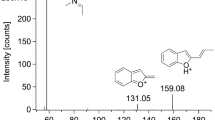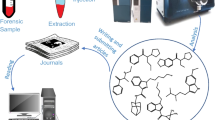Abstract
The prevalence of new psychoactive substances (NPSs) in forensic casework has increased prominently in recent years. This has given rise to significant legal and analytical challenges in the identification of these substances. The requirement for validated, robust and rapid testing methodologies for these compounds is obvious. This study details the analysis of 13 synthesised diphenidine derivatives encountered in casework using presumptive testing, thin layer chromatography and gas chromatography–mass spectrometry (GC-MS). Specifically, the validated GC-MS method provides, for the first time, both a general screening method and quantification of the active components for seized solid samples, both in their pure form and in the presence of common adulterants.

Chemical synthesis and forensic analysis of 13 diphenidine-derived new psychoactive substance(s)







Similar content being viewed by others
References
Lemahieu J-L, Me A. World Drug Report 2015. United Nations Office on Drugs and Crime. 2015. https://www.unodc.org/documents/wdr2015/World_Drug_Report_2015.pdf, accessed 29 June 2016.
Smith JP, Sutcliffe OB, Banks CE. An overview of recent developments in the analytical detection of new psychoactive substances (NPSs). Analyst. 2015;140:4932–48.
Morris H, Wallach J. From PCP to MXE: a comprehensive review of the non-medical use of dissociative drugs. Drug Test Anal. 2014;6(7–8):614–32.
Wallach J, Kavanagh PV, McLaughlin G, Morris N, Power JD, Elliot SP, et al. Preparation and characterisation of the “research chemical” diphenidine, its pyrrolidine analogue, and their 2,2-diphenylethyl isomers. Drug Test Anal. 2015;7(5):358–67.
McLaughlin G, Morris N, Kavanagh PV, Power JD, O’Brien J, Talbot B, et al. Test purchase, synthesis and characterization of 2-methoxydiphenidine (MXP) and differentiation from its meta- and para-substituted isomers. Drug Test Anal. 2016;8(1):99–110.
Reuter P, Pardo B. Can new psychoactive substances be regulated effectively? An assessment of the British Psychoactive Substances Bill. Addiction 2016; Article in Press. doi:10.1111/add.13439.
Helander A, Beck O, Baeckberg M. Intoxications by the dissociative new psychoactive substance diphenidine and methoxphenidine. Clin Toxicol. 2015;53(5):446–53.
Hasegawa K, Wurita A, Minakata K, Gonmori K, Nozawa H, Yamagishi I, et al. Postmortem distribution of AB-CHMINACA, 5-fluoro-AMB, and diphenidine in body fluids and solid tissues in a fatal poisoning case: usefulness of adipose tissue for detection of drugs in unchanged forms. Forensic Toxicol. 2015;33(1):45–53.
Minakata K, Yamagishi I, Nozawa H, Hasegawa K, Gonmori K, Suzuki M, et al. Semiquantification of diphenidine is tissue sections obtained from a human cadaver in a poisoning case by direct MALDI-QTOF mass spectrometry. Forensic Toxicol. 2016;34(1):151–7.
Kudo K, Usumoto Y, Kikura-Hanajiri R, Sameshima N, Tsuji A, Ikeda N. A fatal case of poisoning related to new cathinone designer drugs, 4-methoxy PV8, PV9 and 4-methoxy PV9, and a dissociative agent, diphenidine. Leg Med. 2016;17(5):421–6.
Odoardi S, Romolo FS, Strano-Rossi S. A snapshot of NPS in Italy: distribution of drugs in seized materials analysed in an Italian forensic laboratory in the period 2013–2015. Forensic Sci Int. 2016;265:116–20.
Strano-Rossi S, Odoardi S, Gregori A, Peluso G, Ripani L, Ortar G, et al. An analytical approach to the forensic identification of different classes of new psychoactive substances (NPSs) in seized materials. Rapid Commun Mass Spectrom. 2014;28(17):1904–16.
Wurita A, Hasegawa K, Minakata K, Watanabe K, Suzuki O. A large amount of new designer drug diphenidine coexisting with a synthetic cannabinoid 5-fluoro-AB-PINACA found in a dubious herbal product. Forensic Toxicol. 2014;32(2):331–7.
Jones LE, Stewart A, Peters KL, McNaul M, Speers SJ, Fletcher NC, et al. Infrared and Raman screening of seized novel psychoactive substances: a large scale study of >200 samples. Analyst. 2016;141(3):902–9.
Uchiyama N, Shimokawa Y, Kawamura M, Kikura-Hanajiri R, Hakamatsuka T. Chemical analysis of a benzofuran derivative, 2-(2-ethylaminopropyl)benzofuran (2-EAPB), eight synthetic cannabinoids, five cathinone derivatives, and five other designer drugs newly detected in illegal products. Forensic Toxicol. 2014;32(2):266–81.
Wink CSD, Michely JA, Jacobsen-Bauer A, Zapp J, Maurer Hans H. Diphenidine, a new psychoactive substance: metabolic fate elucidated with rat urine and human liver preparations and detectability in urine using GC-MS, LC-MSn, and LC-HR-MSn. Drug Test Anal. 2016; Article in Press. doi:10.1002/dta.1946
Odoardi S, Fisichella M, Romolo FS, Strano-Rossi S. High-throughput screening for new psychoactive substances (NPS) in whole blood by DLLME extraction and UHPLC-MS/MS analysis. J Chromatogr B Analyt Technol Biomed Life Sci. 2015;1000:57–68.
Salomone A, Gazzilli G, Di Corcia D, Gerace E, Vicenti M. Determination of cathinones and other stimulant, psychedelic, and dissociative designer drugs in real hair samples. Anal Bioanal Chem. 2016;408(8):2035–42.
Elliot SP, Brandt SD, Wallach J, Morris H, Kavanagh PV. First reported fatalities associated with the “research chemical” 2-methoxydiphenidine. J Anal Toxicol. 2015;39(4):287–93.
Hofer KE, Degrandi C, Muller DM, Zurrer-Hardi U, Wahl S, Rauber-Luthy C, et al. Acute toxicity associated with the recreational use of the novel dissociate psychoactive substance methoxphenidine. Clin Toxicol. 2014;52(10):1288–91.
Fulmer GR, Miller AJM, Sherden NH, Gottlieb HE, Nudelman A, Stolz BM, et al. NMR chemical shifts of trace impurities: common laboratory solvents, organics and gases in deuterated solvents relevant to the organometallic chemist. Organometallics. 2010;29:2176–9.
Yang F, Yu X, Liu C, Qu CX, Gong Z, Liu HD, et al. Phospho-selective mechanisms of arrestin conformations and functions revealed by unnatural amino acid incorporation and 19F-NMR. Nat Commun. 2015;6:8202.
Le Gall E, Haurena C, Sengmany S, Martens T, Troupel M. Three-component synthesis of α-branched amines under Barbier-like conditions. J Org Chem. 2009;74:7970–3.
Rapid testing methods of drugs of abuse. United Nations Office on Drugs and Crime. 1995. https://www.unodc.org/documents/scientific/Rapid_Testing_Methods_of_Drugs_of_Abuse_E.pdf, accessed 29 June 2016.
Validation of analytical procedures: text and methodology Q2(R1). International Conference on Harmonisation (ICH) of technical requirements for registration of pharmaceuticals for human use. http://www.ich.org/fileadmin/Public_Web_Site/ICH_Products/Guidelines/Quality/Q2_R1/Step4/Q2_R1__Guideline.pdf, accessed 29 June 2016.
Kovar K-A, Laudszun M. Chemistry and reaction mechanisms of rapid tests for drugs of abuse and precursor chemicals. United Nations Office on Drugs and Crime. 1989. http://www.unodc.org/pdf/scientific/SCITEC6.pdf, accessed 29 June 2016.
Nagy G, Szöllősi I, Szendrei K. Colour tests for precursor chemicals of amphetamine-type substances the use of colour tests for distinguishing between ephedrine-derivatives. 2005. United Nations Office on Drugs and Crime. http://www.unodc.org/pdf/scientific/SCITEC20-fin.pdf, accessed 29 June 2016.
Nic Daeid N, Savage KA, Ramsay D, Holland C, Sutcliffe OB. Development of gas chromatography–mass spectrometry (GC-MS) and other rapid screening methods for the analysis of 16 ‘legal high’ cathinone derivatives. Sci Justice. 2014;54:22–31.
Khreit OIG, Irving C, Schmidt E, Parkinson JA, Nic Daeid N, Sutcliffe OB. Synthesis, full chemical characterisation and development of validated methods for the quantification of the components found in the evolved “legal high” NRG-2. J Pharm Biomed Anal. 2012;5(61):122–35.
Brandt SD, Freeman S, Sumnall HR, Measham F, Cole J. Analysis of NRG ‘legal highs’ in the UK: identification and formation of novel cathinones. Drug Test Anal. 2011;3(9):569–75.
Smith JP, Metters JP, Khreit OIG, Sutcliffe OB, Banks CE. Forensic electrochemistry applied to the sensing of new psychoactive substances: electroanalytical sensing of synthetic cathinones and analytical validation in the quantification of seized street samples. Anal Chem. 2014;86(19):9985–92.
Author information
Authors and Affiliations
Corresponding author
Ethics declarations
This study did not involve research on human participants or animals.
Conflict of interest
The authors declare no conflict of interest.
Electronic supplementary material
Below is the link to the electronic supplementary material.
ESM 1
(PDF 2147 kb)
Rights and permissions
About this article
Cite this article
Geyer, P.M., Hulme, M.C., Irving, J.P.B. et al. Guilty by dissociation—development of gas chromatography–mass spectrometry (GC-MS) and other rapid screening methods for the analysis of 13 diphenidine-derived new psychoactive substances (NPSs). Anal Bioanal Chem 408, 8467–8481 (2016). https://doi.org/10.1007/s00216-016-9969-y
Received:
Revised:
Accepted:
Published:
Issue Date:
DOI: https://doi.org/10.1007/s00216-016-9969-y




